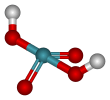Xenic acid
 | |||
| |||
| Identifiers | |||
|---|---|---|---|
3D model (JSmol) |
|||
| ChemSpider | |||
| |||
| |||
| Properties | |||
| H2XeO4 | |||
| Molar mass | 197.31 g/mol | ||
| Related compounds | |||
Related compounds |
Perxenic acid Xenon trioxide | ||
Except where otherwise noted, data are given for materials in their standard state (at 25 °C [77 °F], 100 kPa). | |||
| Infobox references | |||
Xenic acid is a noble gas compound formed by the dissolution of xenon trioxide in water. Its chemical formula is H2XeO4. It is a very powerful oxidizing agent, and its decomposition is dangerous as it liberates a large amount of gaseous products: xenon, oxygen, and ozone. However, this feature is also what makes xenic acid practically useful in syntheses: there is no chance of introducing impurities to the oxidation products, as all the byproducts can be trivially evaporated.
Its existence was hypothesized by Linus Pauling in 1933.[1] Xenic acid has been used as an oxidizing agent in organic chemistry.
Salts of xenic acid are called xenates, containing the HXeO−
4 anion. They tend to disproportionate into xenon gas and perxenates:[2]
- 2 HXeO−
4 + 2 OH−
→ XeO4−
6 + Xe + O
2 + 2 H
2O
The energy given off is sufficient to form ozone from diatomic oxygen:
- 3 O
2 (g) → 2 O
3 (g)
Salts containing the completely deprotonated anion XeO2−
4 are presently unknown.[2]
References
Further reading
- Bruno Jaselskis, Stanislaus Vas (May 1964). "Xenic Acid Reactions with vic-Diols". J. Am. Chem. Soc. 86 (10): 2078–2079. doi:10.1021/ja01064a041.

